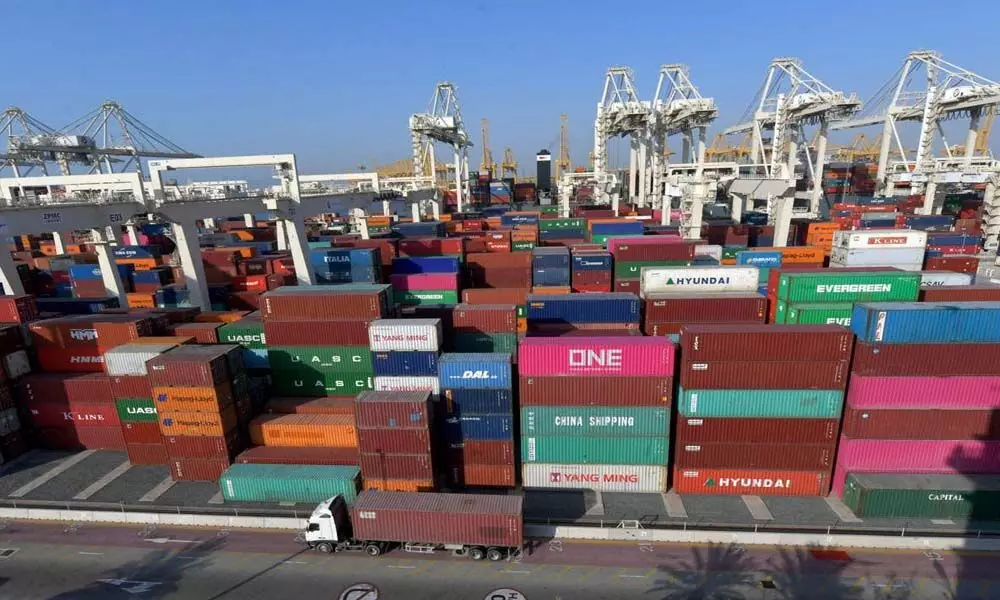India's export set for steep growth in 10 years
Singapore and Hong Kong are regional trade hubs and strategic corridors for India, projected to grow at average of 8.4% and 6.6% per year until 2030, respectively. The USA will continue to be the largest export corridor, accounting for 17% of total exports in 2030
image for illustrative purpose

Mumbai: India's exports are likely to hit $564 billion by 2030, whereas global exports will almost double at $29.7 trillion from $17.4 trillion over the next decade, reveals Standard Chartered Bank report.
The report reveals 13 markets that will drive much of this growth, identifies major corridors, and five trends shaping the future of global trade. India will be a key driver of this global trade growth, with its exports projected to grow at an average annual rate of 7.6 per cent to reach $564 billion by 2030.
Additionally, the research, found that 38 per cent of global corporate currently do or plan to manufacture/source from India within the next five to 10 years. This is evidence that India will be a major driver of global trade growth over the next decade.
Singapore and Hong Kong are regional trade hubs and strategic corridors for India, projected to grow at average of 8.4 per cent and 6.6 per cent per year until 2030, respectively. The USA will continue to be the largest export corridor, accounting for 17 per cent of total exports in 2030, says the report.
India's exports are growing at a healthy rate and are expected to cross $400 billion by the end of the current fiscal. The exports rose 18.8 per cent to $20.01 billion during the three-week period of this month (November 1-21), due to healthy growth in sectors such as petroleum products, engineering goods, chemicals and gems and jewellery, according to the preliminary data of the commerce ministry. India is investing in its manufacturing sector and digital economy to drive economic growth.
"We can expect growth of 12-15 per cent for next decade. We will be diversifying to new goods and regions. By goods we move away from traditional to engineering electronics etc where the PLI also helps. Regions will be moving to Africa too. Also expect more FTA to be inked which will help. Also global growth will be elevated and provide inherent buoyancy," Madan Sabnavis, chief economist, Care credit rating agency said.
Gaurav Bhatnagar, MD & Head, Trade & Working Capital, India & South Asia, Standard Chartered Bank, said, "Global trade has been the engine of economic growth for several years now, and has greatly enabled social, cultural and technological interactions. With India poised to drive global trade growth from the forefront in the current decade, we have an obligation and responsibility to incorporate sustainable and inclusive practices to make trade more equitable."
He further remarked, "Digitisation continues to be a key focus area for us. Increased adoption of technology and innovative digital solutions will result in elevated client experience, more security, and faster trade flows."
The report, commissioned by Standard Chartered and prepared by PwC Singapore, is based on an analysis of historical trade data and projections until 2030, as well as insights from a survey of more than 500 C-suite and senior leaders in global companies.
Global trade will be reshaped by five key trends: the wider adoption of sustainable and fair-trade practices; a push for more inclusive participation; greater risk diversification; more digitisation and a rebalancing towards high-growth emerging markets. Almost 90 per cent of the corporate leaders surveyed agreed that these trends will shape the future of trade and will form part of their five to 10-year cross-border expansion strategies.
Globalisation will drive the next decade of growth. Despite the recent push towards onshoring, growth corridors of the future will not just be intraregional - they will be global spanning Africa-East Asia; ASEAN-South Asia; East Asia-Europe; East Asia- Middle East; East Asia-Europe; South Asia-US.
Asia, Africa and the Middle East will see a ramp-up in investment flows, with 82 per cent of respondents saying they are considering new production locations in these regions in the next five to 10 years, supporting the trend towards rebalancing to emerging markets and greater risk diversification of supply chains.
The research found a significant trend towards the adoption of sustainable trade practices in response to climate concerns and a rising wave of conscious consumerism. However, while almost 90 per cent of corporate leaders acknowledged the need to implement these practices across their supply chains, only 34 per cent ranked it as a 'top three' priority for execution over the next five to 10 years.
Standard Chartered, in line with its commitment to help make global trade more sustainable and drive the transition to Net Zero, launched a Sustainable Trade Finance proposition to enable companies to build more sustainable and resilient supply chains. In addition, we offer a suite of sustainable finance solutions to channel capital towards helping companies achieve their Net Zero goals.
Simon Cooper, CEO Corporate & Institutional Banking and Europe & the Americas, Standard Chartered, said: "The predicted doubling of global trade offers strong evidence that globalisation is still working, despite recent dislocation. In addition to the growth of intra-regional trade pathways, the corridors of the future will still cut across continents.
He added, "Against this backdrop, we continue to focus on making globalisation work for more markets and businesses, ranging from micro to multinational, and drive a more sustainable and inclusive model for global trade. This includes growing our range of sustainable finance solutions to help our corporate clients implement sustainable and fair-trade practices across their supply chains."

